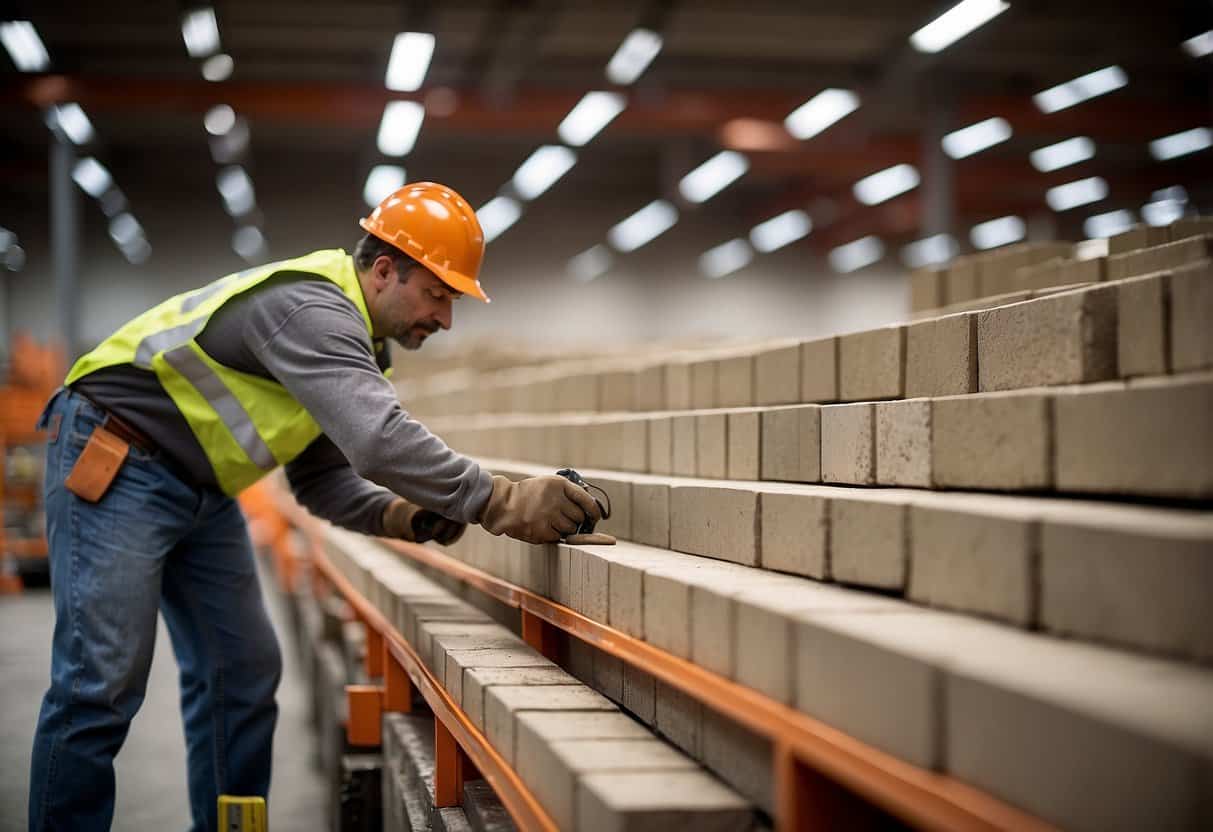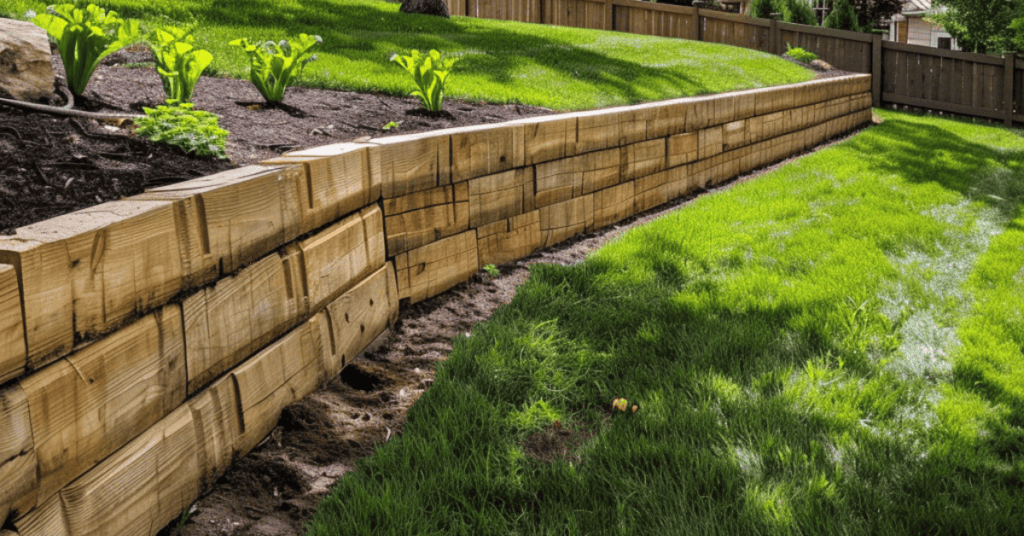Get Your DIY Retaining Wall Project in Motion
Building your own retaining wall is a huge DIY undertaking. If you thrive on home improvement projects, building your own retaining wall is certainly within the realm of possibility. You need to have the time, energy, and funds for materials.
From a materials standpoint, you can get most of what you need for the project from Big Box Stores like Home Depot, Lowe’s, Walmart, and Tractor Supply Company. Home Depot even has a How to Build a Retaining Wall tutorial that is worth checking out.

Building Your Own Retaining Wall Can be a Challenging Project
Why Build a Retaining Wall
Retaining walls keep soil in place on a slope, free up additional usable yard space and help manage drainage on your property.
You can build retaining walls using materials like concrete blocks, wood, or stone. Each material offers its own benefits. Concrete blocks, for example, are durable and easy to work with.
Before Getting Started
Assess Your Landscape Setup
Before building a retaining wall, you need to evaluate your landscape. Determine the slope, soil type, and drainage needs. Check if your site has any existing structures or vegetation that might be affected.
You also need to measure the height and length of the wall. This will help you decide on the material and design. For example, a tall wall might need stronger materials like concrete blocks.
Complying With Building Codes
Before starting construction, check local building codes. Most (if not all) cities and counties along the Front Range may require a permit for retaining walls over a certain height (usually around four feet or so). These codes ensure your wall is safe and stable.
But it isn’t just your local government organizations that you need to consider – don’t forget about your HOA. The HOA might have rules about the appearance, height, and location of retaining walls. Ignoring HOA guidelines can lead to fines or even removal of the wall. Researching and following all rules from the start prevents legal headaches in the future.
Come up With a Drainage Plan: Don’t forget the French Drain
A retaining wall system doesn’t consist solely of a wall. There also needs to be a proper drainage plan for the wall. Retaining walls are built on slopes, and gravity will direct water towards your retaining wall. Water will build at the base of your retaining wall which puts a lot of hydrostatic pressure on your retaining wall.
This intense water pressure can cause your retaining wall to fail unless you direct water away from your retaining wall. Water will need to be directed to an area where it can safely drain away without damaging the wall or nearby properties. The most common way to deal with retaining wall drainage is with a french drain.
Materials for Retaining Walls
Once you have done your research and have a retaining wall location and design, it is time to consider materials for your retaining wall. Retaining walls need specific materials to ensure stability and durability. Key choices include the type of blocks and other essential building materials.
Building a Block Retaining Wall
Retaining walls are typically constructed of wood, stone, or concrete.
Wood Retaining Walls
Wood retaining walls can be very attractive, but are also more prone to wear down due to water erosion, damage from uv rays and infestations from pests like termites. Timber just doesn’t have the same durability as a concrete block.
Brick Retaining Walls
Brick retaining walls provide a fantastic, traditional look. Bricks are typically made with clay and held together with mortar.
Stone Retaining Walls
Stone provides a fantastic, unique look as the stones aren’t of uniform size. A stone retaining wall can look great, but due to their uneven shapes, they are best for smaller retaining walls.
Concrete Retaining Walls
The subject of this article, concrete retaining walls are the most durable and strongest materials for your retaining wall.
Choosing the Right Retaining Wall Blocks
Concrete retaining wall blocks come in various sizes,colors, and designs, allowing you to create a custom look. One popular option is the Pavestone block, known for its robustness. The majority of the retaining wall blocks available at HomeDepot.com are pavestone blocks.
Many blocks feature a locking flange. This design element makes the installation simpler and more stable. Stackable blocks with this feature interlock easily, providing secure construction.
Appearance also matters. Colors like Gray, Tan, Brown and Beige all offer aesthetic appeal while maintaining functionality. This combination ensures a structure that is both strong and visually pleasing.
Concrete Retaining Wall Blocks at Home Depot
Home Depot offers a wide range of options for retaining wall blocks. They provide various styles and competitive prices, ensuring you find the perfect match for your landscaping needs.
Their blocks can be used for various purposes, such as garden bed walls, fire pits, and structural retaining walls. Plus, Home Depot provides guidelines and DIY kits to help you complete your project.
Prices and Availability
Home Depot offers competitive pricing for retaining wall blocks. For example, the Pavestone Trinity Blend Retaining Wall Block sells for about $2.48 each. Most single blocks sell for between $2 and $5 each. You’re probably not going to be buying retaining wall blocks individually unless doing retaining wall repair. You can get a discount on the unit price by purchasing retaining wall blocks by the pallet at Home Depot.
Rockwood Retaining Walls offers precast concrete blocks that are also featured at Home Depot. These blocks are used to create durable and aesthetically pleasing walls, fire pits, raised garden beds, and other vertical structures. The blocks can hold back soil and manage changes in elevation in landscaping projects.
Some key features of Rockwood Retaining Walls blocks include:
- Interlocking Design: Many Rockwood blocks are designed to interlock with each other, providing stability and making the construction process easier.
- Variety of Styles and Colors: They come in various styles, textures, and colors to match different aesthetic preferences and landscaping needs.
- Durability: Made from high-quality concrete, these blocks are built to withstand the elements and provide long-lasting support.
- Ease of Installation: They are designed to be user-friendly, often requiring no mortar, which simplifies the installation process.
- Versatility: Suitable for a range of applications from small garden walls to large structural retaining walls.
Availability varies by location, but you can check stock online. You can also choose to buy online and pick up in-store, which makes it convenient. Additionally, Home Depot often provides free shipping for selected products, making it easier to get everything you need.
Additional Material and Equipment Requirements
Blocks aren’t the only retaining wall materials you’ll need to complete your wall. Aside from blocks, other materials play vital roles – and you can pick up most of these materials from the Garden center at Home Depot. First, you need gravel for proper drainage for your french drain system. As part of the French Drain, you’ll also need perforated piping with a mesh sock that allows water to enter the drain pipe – without letting sand or debris in.
You also need landscape fabric. This fabric goes behind the blocks to prevent soil from seeping through the cracks. It enhances long-term stability by minimizing erosion. The fabric is also used as part of the french drain system.
A solid base is critical. Use a layer of compacted gravel at the bottom before laying the blocks. This creates a firm foundation.
Additional supplies include glue for binding the top layers, adhesive or mortar if you aren’t using interlocking blocks, and a level to ensure accuracy during construction. If you’re

Concrete Blocks are Among the Strongest and Most Durable Options for Retaining Walls
Frequently Asked Questions
This section covers key points like cost-effective blocks, securing methods, and required foundations for retaining walls.
What Other Stores Sell Retaining Wall Blocks besides Home Depot?
Lowe’s also offers a variety of retaining wall blocks with prices and selection similar to those offered by Home Depot. Tractor Supply Company offers interlocking landscape border wall materials for delivery or pickup. For a DIY project, it would be wise to check out these – and other retailers – to compare pricing and selection prior to getting started.
How are retaining wall blocks secured together?
Retaining wall blocks often use a pin system or lip to lock in place. Some systems also use adhesive for extra stability. Interlocking blocks offer great stability and ease of installation. They help prevent shifting and settle into the ground faster.
What type of foundation is required for a block retaining wall?
A solid foundation with a base of gravel works best. Use stones sized between 1/2-inch and 3/4-inch. Fill the trench with a 2- to 3-inch layer of gravel, as advised in this guide.
How do large retaining wall blocks compare to smaller ones in terms of installation and stability?
Large blocks cover more area quickly and provide strong support. Smaller blocks are easier to handle but take more time to install.






